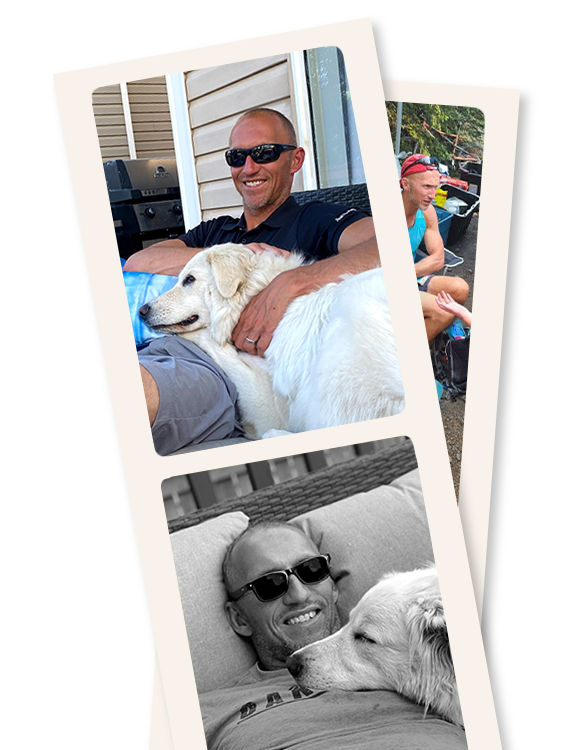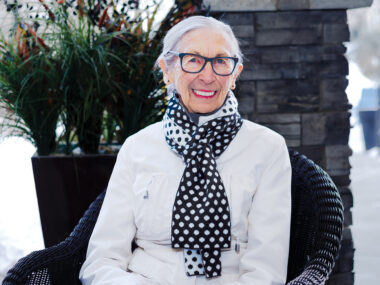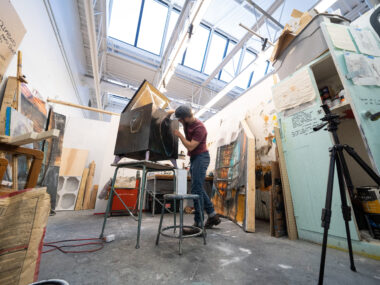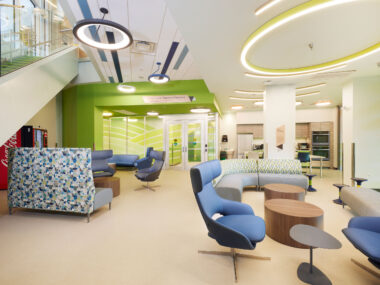Written by Jacquie Moore, BA’97
Ahead of the curve by a longshot, Dr. Thomas O’Neill was using phrases such as “hybrid workplace” and “flexible work schedule” long before COVID-19 came along.

O’Neill, BA’05, PhD, is a star industrial/organizational researcher and psychology professor in the Faculty of Arts at the University of Calgary who also leads the Individual and Team Performance Lab. His research looks at how work teams and individuals can maximize efficiency, personal wellness and team health, specifically in hybrid work situations.
Here’s how O’Neill gets energized, stays organized and slays procrastination.
The pandemic changed how many of us work; presumably, you were already working differently than most. How do you approach your own work style and environment?
Coming out of the pandemic, I reflected on that myself. I’ve known since I was 20 what kind of work style and environment I wanted — I just needed to figure out a job that would allow me [the] autonomy I wanted. There’s still a pervasive mindset on being in the office. It’s different for everyone depending on your reporting arrangement, but we need to be comfortable with who we are and how we work, not be worried about judgment. Sometimes, we can’t do exactly what we want, but that’s what I strive for.
How do you use your space when you work at home?
I have different areas in my house in which I like to work. If I’m banging out emails, I’ll go on the deck if it’s a nice day or I’ll sit at the table in the kitchen. For deep-focus work, I’m in the office with three monitors, the door closed. I admit I get upset if someone interrupts my focus. I tend to be so focused, I can’t process a disturbance. As a hybrid-work researcher, I work where and when I’m most effective — a.k.a., “activity-based working.” I don’t like to be at my computer for eight hours straight, even with a lunch break.
Whether you’re at home or the office, how do you push past the inevitable doldrums of a workday to stay energized?
I walk my dog mid-morning, after a few hours of writing or deep-focus work. Standing desks are a good option, but they don’t get your heart rate up like walking does — walking puts you in a different mindset; it gets my creative mind going. A walk-and-talk meeting can also be a good way to stay energized. I come back from a walk refreshed and then get into a flow — sometimes I’ll even eat lunch at my desk just to keep it going. As well, I’m very careful with how I spend my time, even when it comes to what might seem like a small decision. Maybe I don’t need to craft and send that email right now — I try to free up my brain and conserve my energy for what I need to accomplish.
Coming out of the pandemic, the value of traditional workplace settings has been widely questioned. What’s the office good for?
An office environment is good for information-sharing: brainstorming, collaborating, making strategic plans. It’s for convergence activities when we need to come to consensus and ask difficult questions where in-person body language makes a difference. In video meetings, sometimes you don’t bother saying something because of the delays.
And what do you see as the potential weakness of an office setting?
Too many meetings. We have one weekly lab meeting, on a Monday or Tuesday, but a meeting is an expensive activity, and I am very against meetings. They should be the last resort — there is meeting burnout. Figure out what you are resolving over a meeting, that you can’t resolve over email or other asynchronous channels.
For some of us, working at home brought with it new ways to procrastinate — it creeps in at home as much as at the office. How do you stay on task?
I’ve learned to be ruthless with my time, to be really strict with my calendar and my schedule so I’m much more efficient than I used to be. I’m usually finished my workday by 3:30 or 4. Although I admit I may fire up my computer for focused work in the late evening, but I try not to do it due to having procrastinated during the day against a deadline on the following day.
Also, we pay penalties for task-switching; we lose our flow. So, I keep my routine consistent. If I start a task, even the day before, my mind starts working on the problem and I just want to get it done. Opening files, getting them in front of me, understanding the task — then I can’t wait to get it done.
Even if we really want to get something done, when we let projects stagnate, they can turn into an emotional project and we become frustrated, angry or even scared of a project. For me, it helps to look at what I have coming up in terms of priorities. For instance, on Thursday, I look a week out and, on Friday, I look a month out. I’m also in a routine where, at the end of my day, I always check what my next day holds. Then I put together a must-do list. I find I always have a lot of nice-to-haves on the lists, but I focus on the hard deadlines and commitments that keeps me aware of my priorities.
It helps if I have a sense of the big picture — like let’s say whether or not to take a meeting. I have a lot of requests for my time in meetings, and I can’t possibly accept every meeting request I get. If I keep the big picture in mind, I know if that is an essential meeting or one I have to decline (politely and respectfully, of course).
How do you motivate others to work independently and get the best from them?
I select the right person for the role based on their interest and motivation. I give them an important piece of work to do and explain how it contributes. This creates broader meaning for the work. Too many people think the boss has to motivate their direct reports. I prefer to take a design-based approach, which involves selecting the right person and giving them work that’s personally meaningful and developmental for them. Then, motivation takes care of itself.
How does your “efficiency mindset” impact the way you teach?
Better teaching practices include less time in classroom and more engaging work that can be done outside of the classroom. The traditional, didactic, one-way in-class teaching style does not work. What I do in my classes now are mini-lecture videos, which are efficient for me and for my students. Students can watch and learn when they are most ready to be receptive to the information, and re-watch content whenever they want on an individual basis. Bums in seats do not necessarily equal student learning!
There’s a mental-health crisis right now, and we can be better teachers if we incorporate activity-based learning models – models that meet learners where they are, and recognize there is a diversity of learning styles and student needs. We need to think about what the student experience actually is and be much more student centered. That will not only improving learning and engagement, but also help address the student mental health crisis.
Dr. Thomas O’Neill highlights how flexible work models contribute to teams and individuals reaching their full potential in an article for UToday.



